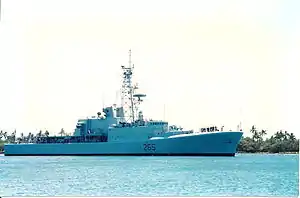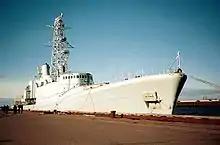Annapolis-class destroyer
The Annapolis-class destroyer escort was a two-ship class of destroyer escorts that saw service with the Royal Canadian Navy and Canadian Forces from the 1960s to the 1990s. The final version of the St. Laurent-class design,[1] the class was used extensively for anti-submarine warfare purposes. Both ships were sunk as artificial reefs after being retired, one on each coast of Canada.
_underway_on_1_September_1985_(6409100).jpg.webp) HMCS Nipigon underway during NATO Exercise Ocean Safari '85. | |
| Class overview | |
|---|---|
| Name: | Annapolis class |
| Builders: | |
| Operators: | |
| Preceded by: | Mackenzie class |
| Succeeded by: | Iroquois class |
| Built: | 1960–1964 |
| In commission: | 1964–1998 |
| Planned: | 2 |
| Completed: | 2 |
| Retired: | 2 |
| General characteristics | |
| Type: | Destroyer escort |
| Displacement: | 3,420 long tons (3,474.9 t) full load |
| Length: | 366 ft (112 m) |
| Beam: | 42 ft (13 m) |
| Draught: | 23.5 ft (7.2 m) |
| Propulsion: |
|
| Speed: | 28 kn (51.9 km/h; 32.2 mph) |
| Complement: | 228 |
| Sensors and processing systems: |
|
| Electronic warfare & decoys: |
|
| Armament: |
|
| Aircraft carried: | 1 CH-124 Sea King ASW helicopter |
| Aviation facilities: | Midships helicopter deck and hangar with Beartrap. |
Design and description

The Royal Canadian Navy had intended to place a six ship order under the Mackenzie class of destroyer escorts; however, during the design phase, the last two vessels ordered were altered to the St. Laurent DDH design and were classed under the new Annapolis designation.[2]
The ships measured 366 feet (112 m) in length, with a beam of 42 feet (13 m) and a draught of 13 feet 2 inches (4.01 m).[3][note 1] Initially, the ships displaced 2,400 tonnes (2,400 long tons)[4][note 2] and had a complement of 228.[1][note 3]
The ships were powered by two Babcock & Wilcox boilers connected to the two-shaft English-Electric geared steam turbines providing 30,000 shaft horsepower (22,000 kW).[3] This gave the ships a maximum speed of 28 knots (52 km/h; 32 mph).[4]
The ships were initially armed with two 3-inch (76 mm)/50 calibre[note 4] dual-purpose guns mounted in a single turret forward. The extra topweight of the helicopter required the return of the American Mk 33 3-inch gun over the heavier 3-inch/70 calibre guns used on the preceding class.[1] The 3-inch/50s weighed 1,760 pounds (800 kg) and fired a projectile that weighed 24 pounds (11 kg). The guns had a muzzle velocity of 2,700 feet per second (820 m/s) and a range of 14,600 yards (13,400 m) at a 45° angle. The guns could fire 45 – 50 rounds per minute with a lifespan of 2,050 rounds. The guns were placed in a Mk 33 mount. The mounting allowed the guns to elevate from −15° to 85°. The elevation rate was 30° per second and train rate was 24° per second. The mounts could train 360°.
For anti-submarine warfare, the ships were armed with a Mk 10 Limbo mortar.[1] The Limbo was a British-designed three-barrel mortar capable of launching a projectile shell between 400–1,000 yards (370–910 m). Placed on stabilized mountings, the projectiles always entered the water at the same angle. The total weight of the shell was 390 pounds (180 kg).[6] They also had a Mk.4 thrower with homing torpedoes.[4]
Initially the ships were outfitted with one SPS-12 air search radar, one SPS-10B surface search radar, and one Sperry Mk.2 navigation radar.[1] For sensing below the surface, the class was given one SQS-501 high frequency bottom profiler sonar, one SQS-502 high frequency mortar control sonar, one SQS-503 hull mounted active search sonar and one SQS-504 VDS medium frequency active search sonar.[1] For fire control purposes they were given one Mk 60 GFCS fire control with SPG-48 tracker (GUNAR).[7]
The two Annapolis-class destroyers were built late enough to incorporate the helicopter hangar retrofitted to the St. Laurent class and the "Beartrap" haul-down device.[4] This allowed the destroyer escorts to deploy with one CH-124 Sea King helicopter.[4]
DELEX refit

The DEstroyer Life EXtension (DELEX) refit was born out of the need to extend the life of the steam-powered destroyer escorts of the Canadian Navy in the 1980s until the next generation of surface ship was built. Encompassing all the classes based on the initial St. Laurent (the remaining St. Laurent, Restigouche, Mackenzie, and Annapolis-class vessels), the DELEX upgrades were meant to improve their ability to combat modern Soviet submarines,[8] and to allow them to continue to operate as part of NATO task forces.[9]
Nipigon underwent a DELEX refit in 1982 and Annapolis followed in 1984. The Annapolis class received the same sensor and communications upgrades that others in the St Laurent family of ships received, including the installation of a new tactical data system (ADLIPS), updated radars and sonars, fire control and satellite navigation. They also received the new Canadian Tactical Towed Array Sensor or CANTASS which was a long-range towed sonar array that was affixed to the stern,[10] which replaced the older VDS.[4] The class also received a new lattice mast.[10] The AN/SPS-503 radar was installed, the AN/SPS-10D replaced the older, AN/SPS-10 model. The AN/SQS-502, AN/SQS-503 and SQS-10/11 sonars were removed and replaced by AN/SQS-505(V) in a fixed dome below the waterline. The installation of the two ADLIPS units allowed the vessels to better integrate into NATO units.[11]
They were given 12.75-inch (324 mm) torpedo tubes to allow them to fire Mark 46 torpedoes. However, the Limbo mortar was removed in order to install the CANTASS. This visibly altered the overall appearance of the ships.[4] The AN/SQR-504 was also replaced by the CANTASS. The Super RBOC chaff system was installed during the refit.[11]
Ships
| Number | Name | Builder | Laid down | Launched | Commissioned | DELEX refit | Paid off | Fate |
| 265 | Annapolis | Halifax Shipyards Ltd., Halifax | 2 September 1961 | 27 April 1963 | 19 December 1964 | 15 September 1986 | 15 November 1996 | Scuttled off Gambier Island in 2015. |
| 266 | Nipigon | Marine Industries Ltd., Sorel | 5 August 1960 | 10 December 1961 | 30 May 1964 | 22 August 1984 | 7 July 1998 | Scuttled off Rimouski, QC in 2003. |
Service history
Nipigon was laid down by Marine Industries Ltd on 5 August 1960 and Annapolis by Halifax Shipyards on 2 September 1961. Both ships commissioned in 1964; Nipigon on 30 May and Annapolis on 19 December.[12]
Both ships spent the majority of their career split between Canada's Pacific and Atlantic coasts with the Annapolis being at Esquimalt and Nipigon at Halifax. They spent most of their careers participating in training exercises, such as Ocean Safari '87[4] or representing Canada at ceremonial situations, such as commemorating the Battle of the Atlantic in May 1993 at Liverpool.[13]

In 1994, Annapolis participated in Operation Forward Action off Haiti.[4] In 1995, after illegal fishing had taken place in Canada's exclusive economic zone, Nipigon was sent to support Canadian Coast Guard and Fisheries vessels in apprehending the perpetrators, in what became called the Turbot War.[13]
Nipigon remained in the fleet until 1998 as a trials ship for the ETASS Mod 5 towed sonar system which was a precursor to the CANTASS that is currently fitted on the Halifax class of frigates.[14] Both Annapolis and Nipigon were paid off on 1 July 1998.[12] Nipigon was towed to Rimouski, Quebec and sunk as an artificial reef off the coast.[13] After years of court battles, Annapolis was sunk as an artificial reef off Gambier Island, British Columbia in 2015.[15]
References
Notes
- Macpherson and Barrie have the ships at 371 feet long, and a draught of 13 feet 8 inches.
- Macpherson and Barrie state that the displacement was 2,400 tons, while Conway's claims it was the same as the St. Laurent class, which was 2,000 tons.
- Macpherson and Barrie have the complement at 246. (12 officers and 234 enlisted)
- Calibre denotes the length of the barrel. In this case, 50 calibre means that the gun barrel is 50 times as long as it is in diameter
Citations
- Gardiner and Chumbley, p. 46
- Hadley, p. 141
- Gardiner and Chumbley, p. 44
- Macpherson and Barrie (2002), p. 260
- "Britain ASW Weapons". navweaps.com. 30 May 2015. Retrieved 14 November 2015.
- Sharpe, Richard, ed. (1989). Jane's Fighting Ships 1989-90. Jane's Information Group. p. 77. ISBN 978-0710608864.
- Milner, pp. 277–278
- Gimblett, p. 179
- Milner, p. 278
- Barrie and Macpherson (1996), p. 17
- Macpherson and Barrie (2002), pp. 260–261
- Macpherson and Barrie (2002), p. 261
- "Royal Canadian Navy Destroyer Escorts (Annapolis Class)". Shearwater Aviation Museum. Archived from the original on 16 March 2016. Retrieved 7 November 2015.
- "HMCS Annapolis sunk to make artificial reef". CBC News. 4 April 2015. Retrieved 7 October 2015.
Sources
- Barrie, Ron; Macpherson, Ken (1996). Cadillac of Destroyers: HMCS St. Laurent and Her Successors. St. Catharines, Ontario: Vanwell Publishing Limited. ISBN 1-55125-036-5.
- Gardiner, Robert; Chumbley, Stephen; Budzbon, Przemysław, eds. (1995). Conway's All the World's Fighting Ships 1947–1995. Annapolis, Maryland: Naval Institute Press. ISBN 1-55750-132-7.
- Gimblett, Richard H., ed. (2009). The Naval Service of Canada 1910–2010: The Centennial Story. Toronto: Dundurn Press. ISBN 978-1-4597-1322-2.
- Hadley, Michael L.; Huebert, Rob; Crickard, Fred W., eds. (1992). A Nation's Navy: In Quest of Canadian Naval Identity. Montreal, Quebec and Kingston, Ontario: McGill-Queen's University Press. ISBN 0-7735-1506-2.
- Macpherson, Ken; Barrie, Ron (2002). The Ships of Canada's Naval Forces 1910–2002 (Third ed.). St. Catharines, Ontario: Vanwell Publishing Limited. ISBN 1-55125-072-1.
- Milner, Marc (2010). Canada's Navy: The First Century (Second ed.). Toronto: University of Toronto Press. ISBN 978-0-8020-9604-3.
External links
| Wikimedia Commons has media related to Annapolis class destroyers. |